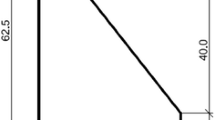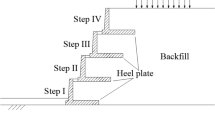Abstract
A hybrid method of limit equilibrium and finite element internal force for analysis of arch dam stability against sliding is presented. The finite element internal force method (FEIFM) is used to provide more accurate thrust forces acting on the faces of a slip body, and the limit equilibrium method (LEM) is employed to evaluate the factor of safety of the slip body. The method presented can deal with a slip body with large amount of geometrically complex slip faces. In addition, compared with the traditional LEM, it can meet the balance condition of the forces in the slip faces. An example shows that the factor of safety obtained by the method presented agrees well with the theoretical solution. A practical example is also presented to demonstrate the application of the method in the stability analysis of an arch dam project. The results from the examples show that the method is promising in analysis of arch dam stability against sliding.
Similar content being viewed by others
References
Griffiths D W, Lane P A. Slope stability analysis by finite elements. Geotechnique, 1999, 49(3): 387–403
Yu X, Zhou Y F, Peng S Z. Stability analyses of dam abutments by 3D elasto-plastic finite-element method: A case study of Houhe gravity-arch dam in China. Int J Rock Mech Mining Sci, 2005, 42(3): 415–430
Bishop A W. The use of the slip circle in stability analysis of slopes. Geotechnique, 1955, 5(1): 7–17
Morgenstern N R, Price V E. The analysis of stability of general slip surfaces. Geotechnique, 1965, 15(1): 79–93
Spencer E. A method of analysis of the stability of embankments assuming parallel inter-slice forces. Geotechnique, 1967, 17(1): 11–26
Duncan J M. State of the art: Limit equilibrium and finite-element analysis of slopes. J Geotechn Eng, 1996, 122(7): 577–596
Chen S H, Qing W X, Isam S. Comparative study of rock slope stability analysis methods for hydropower projects. Mech Res Commun, 2007, 34(1): 63–68
Sharma S, Raghuvanshi T, Sahai A. An engineering geological appraisal of the Lakhwar dam, Garhwal Himalaya, India. Eng Geol, 1999, 53(3–4): 381–398
Fairhurst C, Lorig L. Improved design in rock and soil engineering with numerical modeling. In: Sharma V M, Saxena K R, Woods R D, eds. Distinct Element Modeling in Geomechanics. Rotterdam, Netherlands: Balkema, 1999. 27–46
Zhang C H, Pekau O A, Jin F, et al. Application of distinct element method in dynamic analysis of high rock slopes and blocky structures. Soil Dyn Earthq Eng, 1997, 16(6): 385–394
Goodman R E, Powell C. Investigations of blocks in foundations and abutments of concrete dams. J Geotech Geoenviron Eng, 2003, 129(2): 105–116
Kottenstette J T. Block theory techniques used in arch dam foundation stability analysis. Int J Rock Mech Min Sci, 1997, 34(3–4): 1–19
Dawson E M, Roth W H, Drescher A. Slope stability analysis by strength reduction. Geotechnique, 1999, 49(6): 835–840
Matsui T, San K C. Finite element slope stability analysis by shear strength reduction technique. Soils Found, 1992, 32(1): 59–70
Wei W B, Cheng Y M, Li L. Three-dimensional slope failure analysis by the strength reduction and limit equilibrium methods. Comput Geotechn, 2009, 36(1–2): 70–80
Abramson L W, Lee T S, Sharma S, et al. Slope Stability and Stabilisation Methods. Chichester: Wiley, 1995
Copen M D, Lindholm E A, Tarbox G S. Design of concrete dams. In: Golze A R. Handbook of Dam Engineering. New York: Van Nostrand Reinhold, 1977
Fu Z X, Qian X D. Application of finite element method to the design of arch dams. J Hohai Univ, 1991, 19(2): 8–15
Li T C, Wen Z W. The method of finite element internal force for analysis. J Hydroelectr Eng, 2002, 79(4): 18–24
Zhang J H, He J D, Fan J W. Static and dynamic stability assessment of slopes or dam foundations using a rigid body-spring element method. Int J Rock Mech Min Sci, 2001, 38(8): 1081–1090
Author information
Authors and Affiliations
Corresponding author
Rights and permissions
About this article
Cite this article
Bao, T., Xu, B. & Zheng, X. Hybrid method of limit equilibrium and finite element internal force for analysis of arch dam stability against sliding. Sci. China Technol. Sci. 54, 793–798 (2011). https://doi.org/10.1007/s11431-011-4312-5
Received:
Accepted:
Published:
Issue Date:
DOI: https://doi.org/10.1007/s11431-011-4312-5




